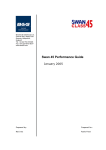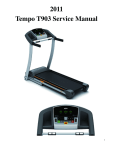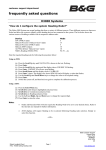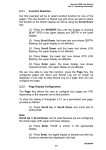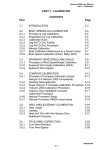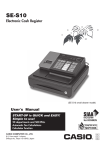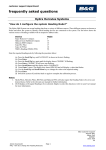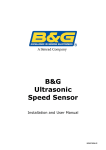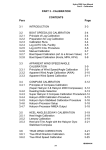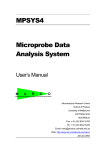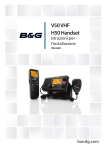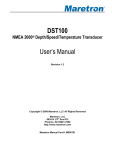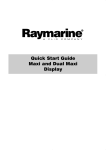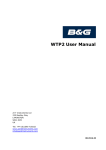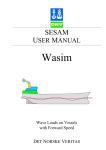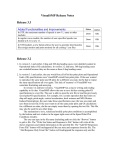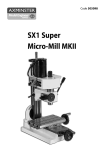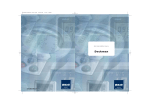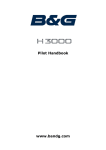Download X-35 Tuning Guide (Final) 2006.qxd - X
Transcript
X-35 Performance Guide 2006 www.simradyachting.com INTRODUCTION B&G has been involved with the X-35 Class from the very beginning when we consulted on the specification of the electronics. Having now worked with the first boat in the UK during the first season we have now released our guide to the use of instruments onboard such that you can truly maximise your performance and have accurate data to help assess changes to sails, trim and set-up. INSTRUMENT CALIBRATION Accurate calibration of your chosen instrument system is essential for ensuring that you are getting meaningful information that you can then use to measure the performance of the yacht. The following sections describe how to do this on a typical B&G system and where appropriate the headings detail the relevant B&G menu structure. Inputting of these values can be completed via the standard FFD or using the new RemoteVision, a wireless link to your Hydra and Hercules instrument system. Depth DEPTH > DEPTH + CALBRATE > DATUM For obvious safety reasons depth should be calibrated before any other function. A DATUM (offset value) is set such that the depth display refers either to the waterline or bottom of the keel. Enter a positive number for waterline or a negative number for keel. Typical X-35 value: -1.9m for depth below keel. 1 www.simradyachting.com Heading In order to eliminate compass deviation errors caused by magnetic fields in the yacht, heading calibration is carried out using B&G's Autoswing. An offset is then entered to account for the alignment of the compass as installed on the yacht. 1. Autoswing NAVIGATE > COMP CAL + CALBRATE > START Prior to commencing the swing ensure that no magnetic or large metallic objects are placed near the compass. Choose a calm open stretch of water and then begin the calibration process as outlined in the User Manual. Ensure you steer a steady circle not exceeding 2-3 degrees per second with a boat speed less than 5 knots. 2. Offset NAVIGATE > HEADING + CALBRATE > CAL VAL 1 Having completed the swing, compare the compass heading with the bearing of a known transit and correct it by entering an offset value. Boatspeed All the work in the world on target speeds and angles, or on polar tables goes to waste if boatspeed is inaccurate, even by a few degrees. True wind calculations and performance functions depend on this input being accurate. If boat speed is wrong, the whole system's data quality is compromised. • It is important to keep an eye on boatspeed accuracy during the course of a season as paddlewheels do suffer from friction and hence changes in physical characteristics can occur over time. • Regular cleaning of the paddlewheel is essential for accurate and repeatable speed readings. 2 www.simradyachting.com 1. Auto-Calibration SPEED > BOAT SPD + CALBRATE > AUTO CAL The B&G three run method eliminates any changes in current during the calibration procedure since the runs are carried out in alternate directions. When carrying out each run maintain a constant compass course to ensure that the distance covered is the same as that measured on the chart. If possible choose a measured distance with clearly visible transits marking each end. Typical X-35 value: 3.80 Paddlewheel It is prudent to manually calibrate boatspeed using the trip log function on another FFD whilst running the AUTO CAL feature. By recording the log at the beginning of each run, and recording the log distance run for each leg, we can deduce the error in the current speed calibration. This can be useful to complete a calibration procedure if any of the runs have to be aborted due to a necessary change of course. Example: • Current calibration value in Hz per Kt = 3.42 • Measured run distance = 0.75nm • Run 1 = 0.76nm, Run 2 = 0.72nm, Run 3 = 0.77nm It appears that the current is changing due to the difference in logged distrance for the 1st and 3rd runs. Correct this by averaging run 1 and 3, and then combine with run two to get an overall average log distance: (Run1 + Run3)/2 = 0.765 (Run2 + 0.765)/2 = 0.7425 Comparing the log distance to the actual distance reveals that the log is under-reading by 1% (0.75 - 0.7425) = 1% Increasing SINGLE HZ calibration value in manual calibration reduces boatspeed, and vice versa. 3 www.simradyachting.com Therefore by reducing the SINGLE HZ value for the above calibration by 1% will address the under-reading of the log. 3.42 - 1% = 3.39 If you are using the latest B&G Hercules system with a heel sensor you can also adjust the speed from tack to tack and apply more correction at higher speeds in the case of the paddle-wheel. See the Owner's Manual for more information on this. Once boatspeed has been verified as accurate, it should be monitored against other functions, and only adjusted if the wrong speed cannot be attributed to different sail trim, helms-man, rig settings, wind shear, crew weight and hull fouling. Apparent Wind Calibration If wind is not calibrated accurately, then performance is next to impossible to assess. Proper calibration of the wind function is as vital as selecting the correct head sail for the next upwind leg. 1. Apparent Wind Angle WIND > APP W/A or MEAS W/A > CALBRATE + MHU ANGL Installation offsets and other asymmetric factors can affect the symmetry of measured wind angles. An offset is all that is required to correct for tack-to-tack errors in APP W/A. The perfect scenario for calibrating APP W/A is in non-tidal flat water, with stable conditions (no building sea breeze) and with a correctly calibrated boatspeed. 4 www.simradyachting.com Using identical trim and crew weight distribution (not necessarily a full racing crew) complete half a dozen tacks with the helm concentrating purely on boatspeed. A consistent speed (not necessarily from the targets table) on each tack should be achieved without changing trim, and without using any reference to APP W/A. The navigator or tactician should monitor the APP W/A from tack to tack, and average each tack. Any difference between Port and Starboard tack can be corrected in the MHU offset. If Starboard APP W/A is greater than Port then subtract half the difference from the MHU offset, and vice versa. Once a good APP W/A is achieved, do not change it unless necessary (e.g. rig has been removed from boat, new wind sensor put in place). Any differences seen from now on may be attributable to effects such as wind shear and current. 2. Apparent Wind Speed Do not alter the APP W/S calibration values. This is a wind tunnel based factory setting. True Wind Calibration Tips 1. True Wind Angle Calibration WIND > TRUE W/A + CALBRATE > CORRECTION A TRUE W/A calibration matrix is utilised for corrections upwind, reaching, and downwind across the TRUE W/S ranges. The latest release of the B&G Hercules system (serial numbers greater than H374001) allows you to load an initial set of corrections for a fractionally rigged monohull that will be a good starting point to work from. To do this change CAL VAL 1 on TRUE WIND DIRECTION from 0 to 1. Two methods of calibrating TRUE W/A are available, either monitoring TRUE DIR from tack to tack or gybe to gybe, or using the compass to verify the angles the yacht is tacking or gybing through. 5 www.simradyachting.com 1. If an error is seen in TRUE DIR, then the following rule applies: • If TRUE DIR is lifting you tack to tack then TRUE W/A is reading too wide, half the error must be subtracted from the correction table. • If TRUE DIR is heading you tack to tack then TRUE W/A is reading too narrow, add half the error to the TRUE W/A table. 2. If according to the compass you are tacking through an angle different than the sum of the TRUE W/A's on each tack (Port TRUE W/A + Starboard TRUE W/A) then the following rule applies • If the tack angle < the sum of the TRUE W/A's, the TRUE W/A is reading too wide, half the error must be subtracted from the correction table. • If the tack angle > the sum of the TRUE W/A's, the TRUE W/A is reading too narrow, add half the error to the TRUE W/A table. A Worked Example: Your TRUE DIR is telling you that you are being lifted by 10 degrees from tack to tack (or the sum of your TRUE W/A is 10 degrees more than the angle you are tacking through), and you know this is wrong. This is in 5 kts of TWS. When you go into the TRUE W/A correction table for 5 Kt upwind, you see that a value of -1.5 degrees is already entered. To correct the error you are seeing, a further 5 degrees needs to be subtracted so a total correction of -6.5 degrees is applied. Calibrating and refining TRUE W/A is an ongoing process. Differences in TRUE W/A can been seen from morning to afternoon races as sea breezes develop and changes in gradient conditions. TRUE W/A should be checked at the beginning of every race, any necessary changes made, and the conditions logged for future reference. 6 www.simradyachting.com Typically, when graphed, a TRUE W/A table for upwind might have a curve like the following: If it has only been possible to achieve reliable values for the TRUE W/S 5, 10 and 20 range and the rest of the table left blank then the table would look as follows: It is clear to see that the 15, 25, and 30 kt values can be estimated at as opposed to being left with zero values to keep the curve the right shape. You should repeat the process for reaching and running as well as beating. 2. True Wind Speed Calibration WIND > TRUE W/S + CALBRATE > CORRECTION TRUE W/S errors are seen from sailing upwind to downwind. This is most noticeable on Mast Head boats, however all yachts are affected to some degree. This is due to the acceleration of the airflow over the top of the mast and around the sails when sailing downwind. The introduction of the Vertical Mast Head unit has gone some way to solving this, however calibration may still be necessary. 7 www.simradyachting.com As a rule of thumb, it is safe to put a correction of -10% into the table before the first sailing and this is the value entered by B&G as a factory default. Monitoring the change in TRUE W/S from close hauled to flat running will enable further refinement of this calibration value. On a B&G Hercules system it is also possible to define the TRUE W/A at which this correction is applied - typically your downwind target angle. Typical corrections for TRUE W/A and TRUE W/S for the X-35 TRUE W/S UPWIND TRUE W/A CORRECTION REACHING TRUE W/A CORRECTION DOWNWIND TRUE W/A CORRECTION DOWNWIND TRUE W/S CORRECTION TRUE W/S CORRECTION ANGLE (Hercules Only) 5 10 15 20 25 30 -7.0 -3.0 0.5 4.5 6.5 8.0 -2.0 -1.0 0.0 1.0 1.0 1.5 4.0 3.0 -1.0 -02.0 -2.5 -3.0 -0.5 -1.0 -1.5 -2.0 -2.5 -3 145 155 165 170 165 165 Polars Polars are used to profile a yacht's performance and B&G's Deckman software can be used to store these for comparing actual performance against a set of target polars. The table on Page 9 shows a basic set of polars for the X-35 stored in Deckman, their associated curves are plotted opposite. They are a good starting point but as you sail the boat you will most likely develop these into a set of your own specific to your sails and set-up. 8 www.simradyachting.com Deckman Polar Target Information X-35 Polar Performance Table as shown in Deckman Key First column = True wind speed V1-V5 = Polar boat speeds A1-A5 = True wind angles V1 & A1 = Upwind targets boat speed and angle V4 & A4 = Downwind targets boat speed and angle Deckman is the world’s most advanced race navigation software and is used on winning yachts in a variety of events from local regattas to ocean races and the America’s Cup. You can find out more and download these polars in Deckman format from: www.bandg.com 9 www.simradyachting.com CONCLUSION The information within this guide should help you get up to speed as quickly as possible and then move forward with your own polars based upon an accurately calibrated instrument system. Setting up your instruments can be very rewarding for the whole team. Should you have any questions or further suggestions, please email [email protected]. Author Nat Ives is the B&G Race Specialist where he focuses on ensuring B&G meet the requirements of the best sailors and fastest vessels in the world. His role includes supporting regattas and teams all around the world including all of the current AC and Volvo teams. In addition to this Nat sailed as part of the crew on "Cool Runnings" the first X-35 to sail in the UK winning the Warsash Spring Series 2006. Also navigating professionally, Nat brings with him a wealth of 'big race' experience. He has competed as navigator in a wide range of yachts and events including the TP52 Breitling Med Cup, Swan Cup and Maxi Worlds. 10 www.simradyachting.com












